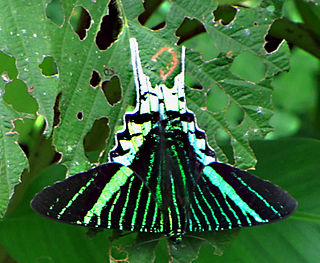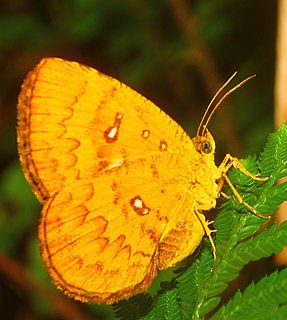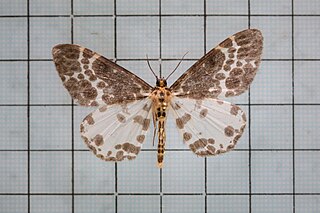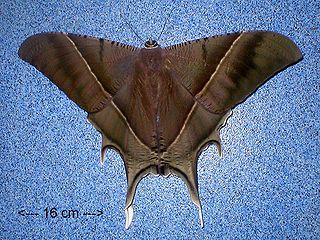Related Research Articles

The Uraniinae or uraniine moths are a subfamily of moths in the family Uraniidae. It contains seven genera that occur in the tropics of the world.

Omiodes is a moth genus in the family Crambidae. Several species are endemic to Hawaii.

Brunia is a genus of tiger moths in the family Erebidae. The genus was described by Moore in 1878.
Tampea is a genus of moths in the subfamily Arctiinae.

Avatha is a genus of moths in the family Erebidae.

Bastilla is a genus of moths in the family Erebidae. The genus was described by Swinhoe in 1918.

Ischyja is a genus of moths of the family Noctuidae erected by Jacob Hübner in 1823.

Zeheba is a genus of moths in the family Geometridae described by Moore in 1887.

Callidula is a genus of moths of the family Callidulidae.

Dilophodes elegans is a moth in the family Geometridae first described by Arthur Gardiner Butler in 1878. It is found in Japan, China, Taiwan, north-eastern Himalaya, Burma and Borneo.
Brunia sarawaca is a moth of the family Erebidae. It was described by Arthur Gardiner Butler in 1877. It is found on Borneo, Peninsular Malaysia, Java and the north-eastern Himalayas. The habitat consists of lowland forests.
Tampea acanthocera is a moth of the subfamily Arctiinae first described by George Hampson in 1905. It is found on Sangihe in Indonesia.
Tampea hammatocera is a moth of the subfamily Arctiinae first described by Wileman and West in 1928. It is found on Luzon in the Philippines.
Thysanoptyx oblonga is a moth of the subfamily Arctiinae first described by Arthur Gardiner Butler in 1877. It is found on Peninsular Malaysia, Sumatra, Java and Borneo. The habitat consists of lowland dipterocarp forests.
Tampea reversa is a moth in the subfamily Arctiinae. It was described by Francis Walker in 1862. It is found on Borneo and Java. The habitat consists of lowland areas and lower montane forests.
Tampea wollastoni is a moth in the subfamily Arctiinae. It was described by Walter Rothschild in 1916. It is found in Papua New Guinea.
Tampea nodosa is a moth in the subfamily Arctiinae. It was described by Jeremy Daniel Holloway in 2001. It is found on Borneo. The habitat consists of lower montane forests and alluvial forests.

Lyssa is a genus of moths in the family Uraniidae. The genus was erected by Jacob Hübner in 1823.
Catocala ella is a moth in the family Erebidae first described by Arthur Gardiner Butler in 1877. It is found in south-eastern Siberia and Japan.

Catocala nivea is a moth in the family Erebidae first described by Arthur Gardiner Butler in 1877. It is found in Japan and Taiwan.
References
- ↑ Savela, Markku. "Tampea accepta (Butler, 1877)". Lepidoptera and Some Other Life Forms. Retrieved October 15, 2019.
- ↑ Holloway, Jeremy Daniel. "Tampea accepta Butler comb. n." The Moths of Borneo. Retrieved October 15, 2019.
- Pitkin, Brian & Jenkins, Paul. "Search results Family: Arctiidae". Butterflies and Moths of the World. Natural History Museum, London.
| This Lithosiini-related article is a stub. You can help Wikipedia by expanding it. |